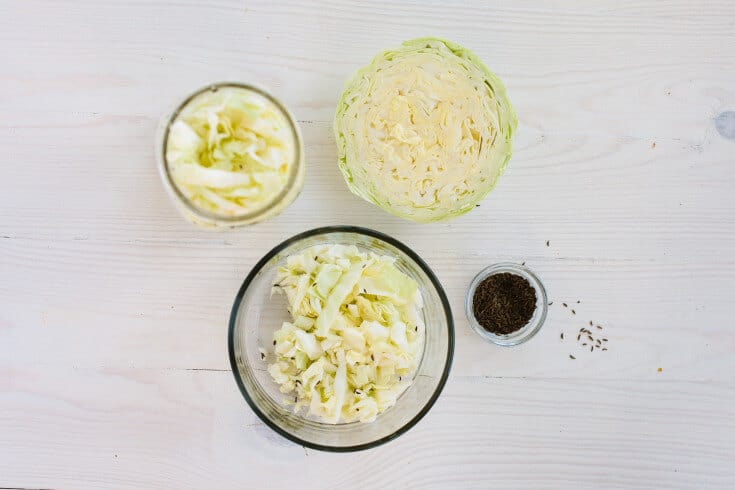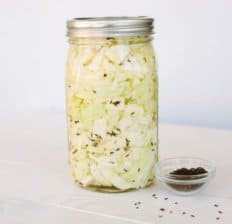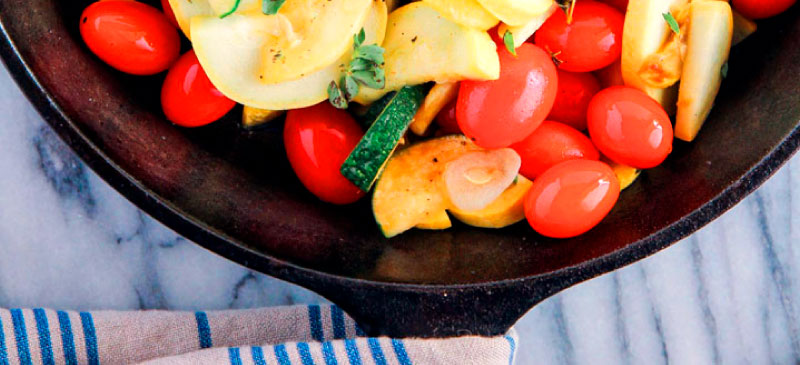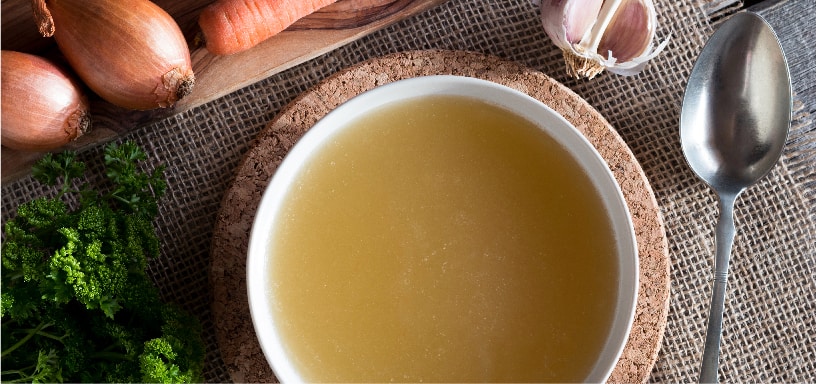Sauerkraut Recipe

Have you heard about the benefits of probiotics? These foods contain bacteria that line your digestive tract, supporting your immune system and absorbing nutrients from foods. One of my favorite foods, sauerkraut, is one of the greatest probiotic foods out there.
Sauerkraut recipes not only tastes great on organic hot dogs, hamburgers or on their own, but fermented foods are rich in organic acids, which stimulate the growth of good bacteria.
What Is Sauerkraut?
Sauerkraut is a form of fermented cabbage and has been popular throughout Central Europe for hundreds of years. Sauerkraut combines one of the healthiest foods there is (cabbage) with one of the most beneficial and time-honored food preparation methods ever used (fermentation).
Sauerkraut is native to Eastern Europe, especially places like Germany, Poland and Russia where cabbage is considered a staple ingredient. Sauerkraut, which means “sour cabbage” in German, first made its way over to the Unites States in the 1700s. It’s been said that immigrants coming over to the Americas at this time on ships carried sauerkraut with them on their long journeys because the fermentation process was able to preserve abundant amounts of harvested cabbage and also provide important nutrients.
Fermentation has been practiced for thousands of years in one form of another in nearly every ancient population on Earth. Fermenting foods — kimchi is a Korean recipe that also uses fermented cabbage — stops them from spoiling quickly, which is why it’s been a tried-and-true method for using up available vegetables, fruits, grains and legumes.
Nutrition Facts
Sauerkraut is very low-calorie, but it’s also an anti-inflammatory food that is packed with benefits. Besides having probiotics to offer, sauerkraut is a good source of antioxidants and dietary fiber, thanks to its main ingredient: cabbage.
A half-cup serving of sauerkraut (about 75 grams) has about:
- 14 calories
- 0 grams fat
- 4 grams fiber
- 3 grams carbohydrates
- 1 grams sugar
- 1 gram protein
- 496 milligrams sodium
- 11 milligrams vitamin C (17 percent DV)
- 10 micrograms vitamin K (8 percent DV)
- 1 milligram iron (6 percent DV)
- 1 milligram manganese (6 percent DV)
- .1 milligram vitamin B6 (6 percent DV)
- 17 micrograms folate (5 percent DV)
How to Make Homemade Sauerkraut
I know you’ll love this homemade sauerkraut recipe. Unlike store-bought options, this version requires just three ingredients for a tasty side that’s packed with nutrients!

Before getting started, it’s important to note that sauerkraut isn’t made to be eaten immediately. The fermenting portion takes time, so you’ll want to plan ahead. With this sauerkraut recipe, I recommend letting it stand for at least four weeks before eating. The good part is, sauerkraut is so easy to make that you can whip up a new batch before finishing the current one, so you’ll always have fresh sauerkraut on hand!
We’ll start with five pounds of shredded cabbage; any type works fine. You can use a large green cabbage and slice it up. Place cabbage on a large wooden cutting board. Remove the outer leaves of the cabbage, then cut the cabbage into quarters and trim out the core. Slice each quarter down its length, into thin ribbons.
Place sliced cabbage in a bowl. Place all of the sliced cabbage into a large mixing bowl and mix with two teaspoon of salt. Let stand for 10 minutes.
With very clean (!) hands, massage the cabbage for about 10 minutes to release juices. Yes, 10 minutes in order to get that liquid out of the cabbage. Consider it a great hand and forearm exercise!
Sprinkle remaining salt on the cabbage as well as optional caraway seeds.

Next, stuff the cabbage into a large glass food container. Top the container with a quartered onion to weigh it down. This helps pack the cabbage down and keep it in the brine you’re making. Then, cover with a paper towel or clean cloth towel and seal it with a rubber band.
Place the whole thing in a cool spot overnight and, in the morning, make sure the sauerkraut is totally submerged in liquid. This is how the magic will happen. Cabbage “scum” will form. Don’t worry, this is totally normal. Check on the cabbage every other day, skimming off any that forms on the surface.
Finally, after at least four weeks, your homemade sauerkraut is ready! Store it safely in an airtight container in the refrigerator for up to six months.
Print
Sauerkraut Recipe
- Total Time: 2 to 4 weeks
- Yield: 1 gallon 1x
- Diet: Vegan
Description
Sauerkraut combines one of the healthiest foods there is (cabbage) with one of the most beneficial and time-honored food preparation methods ever used (fermentation).
Ingredients
- 1 large head of shredded cabbage
- 3 teaspoons pickling salt (or sea salt)
- 1 tablespoon caraway seeds
Instructions
- Place cabbage on a large wooden cutting board. Remove the outer leaves of the cabbage, then cut the cabbage into quarters and trim out the core. Slice each quarter down its length, into thin ribbons.
- Place all of the sliced cabbage into a large bowl and mix with 2 teaspoons of salt. Let stand for 10 minutes.
- With very clean hands, massage the cabbage for about 10 minutes to release juices.
- Sprinkle remaining salt on the cabbage as well as caraway seeds.
- Pack the cabbage mixture into a large glass food container (that is exceptionally clean). Top with a quartered onion to fit inside the container, weighing it down. Or use a glass dish or jar filled with rocks to weigh it down. Cover container with a paper towel or clean cloth kitchen towel and a rubber band.
- Place in a cool spot in your kitchen. Check to make sure the sauerkraut is completely submerged in liquid. Check cabbage every other day for 2 weeks, skimming off of any scum that may form on the surface.
- Let stand for at least 2 to 4 weeks total. Then store in airtight container in the refrigerator for up to 6 months.
Notes
While it’s fermenting, bubbles and foam may appear on top. This means your sauerkraut is fermenting properly! Skim the scum off the top either every couple of days or before refrigerating. If you see any mold, skim it off immediately. Rest assured that your batch will remain good quality.
- Prep Time: 25 min
- Cook Time: 2 weeks
- Category: Side dishes
- Method: Fermentation
- Cuisine: Multi
Nutrition
- Serving Size: 1/2 cup
- Calories: 14
- Sugar: 1g
- Sodium: 496mg
- Fat: 0g
- Carbohydrates: 3g
- Fiber: 4g
- Protein: 1g
- Cholesterol: 0g
Comments
Please keep comments under 200 characters.








Do you add water or a brine over this cabbage
Thank You.
YOU are Life Saving.
-Andi
Will mold form on the kraut under the onion or on top of it?
My friend makes sauerkraut this way. However, she processes the jars of sauerkraut in the canner when done.
Does this eliminate the probiotics?
Is there a way to save homemade sourkrout if you have added too much salt?
You can rinse the kraut when it’s done fermenting and before you put into the fridge. That will remove some of the probiotic benefits but it’s better than throwing it out because it’s too salty.
So I just started my first batch. I followed the directions exactly, and I’m really looking forward to it. It’s like a science experiment for first-timers like me. Sure enough, after massaging the cabbage slices, there was plenty of juice when I put it in the glass jar. So I’m storing it in a dark cool room with a paper towel over it, and in a couple few days if there’s any foam at the top, I will remove it and then put the paper towel on. I’m looking forward to the results, and I want to thank the website owner for sharing this healthy natural way.
Very useful
I have a large head of cabbage I. bought from the Amish in Lancaster PA
I keep organic sauerkraut in my fridge at all times! When suffering from gastric reflux, i eat 3 -4 mouthfuls of sauerkraut. Within 30 minutes the reflux is gone! I learned this from my old German grandmother. She told me that when you’re belching acid out of your stomach from a large meal, that is because you don’t have enough acid in your stomach to digest the food. You don’t need an antacid, you need more acid, thus the sauerkraut, eliminates the problem.
Excellent
Your recipe says make sure it is covered with liquid. But doesn’t say what liquid you are using
The cabbage releases liquid overnight from being salted.
Should be 5he liquid extracted from the cabbage after it is massaged.
Super Duper ❤ Thank You 🙏
What about Liguria you say must be added?
Do you put water over it. You said make sure it is covered.
Ideally, you’ve massaged the cabbage long enough and stuffed it down in the jar that the natural liquid is sufficient.
Thank you for this useful recipe .In Europe the shop bought sauerkraut has Juniper berries in it ., which are healthy for the stomach.
Where does the liquid come from? Do you add water?
See above.
Can you add other vegetables as in Carrots , beans . caluflour , broccoli or others ? Making them ferment also ? Can they be done separately also , the other veggies ? Did you say Fruits can also be done , or am I mistaken ?
Thank you for your time
Stanley Macey
Do we use paper towel or lid? The explanation in the post doesn’t match up well with recipe directions (like mixing with clean hands in bowl, etc).
Google it or watch some YouTube videos to find out and stop being so bloody lazy!
Nothing more annoying than people asking lazy questions when a quick search online will tell them all they need to know.
Or maybe don’t post a “recipe” that doesn’t make any sense? No where in the recipe does it list any liquid. The recipe as posted is confusing and makes absolutely no sense.
It makes plenty of sense. The liquid comes from the cabbage after massaging it for 10 minutes. Ideally, there is no need to add liquid. If you do, just make sure it’s salty water.
So you’re a sourpuss about sauerkraut… haha
Amazing recipe!! Is there another with kimchi?
Yep! https://draxe.com/nutrition/kimchi/ See recipe at bottom of post.
I see that one recipe says use a paper towel and the other says use a lid. Which one is beneficial.. ???
Try both :)